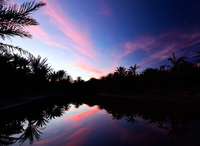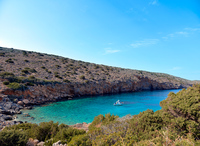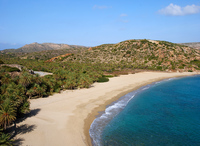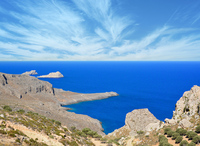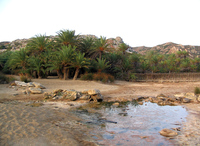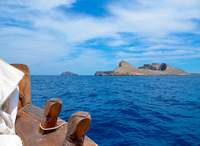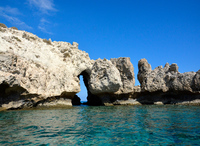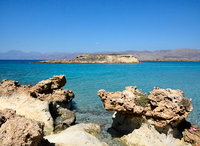Two areas of the Sitia province are integrated to the "NATURA 2000" network (EU guide 92/43/ AIE), which are of great interest, in terms of natural environment.
Kapsa Monastery (gorge of Kapsas and wider region)
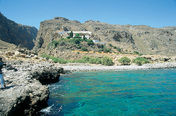
The region is located on the southeast part of Crete, about 35km east from Ierapetra. There is a small gorge -3km long- which has the same name as the monastery (Kapsas), located within the gorge. At the exit of the gorge, towards the sea, there is a small sandy beach with sand dunes. The area has a variety of rock formations and rocky hills. There are also shrubs in very good condition. The sea covers less than 1% of the total area. The kinds of biotope found in the area are: rocky coastlines with Mediterranean vegetation (endemic limonium spp.). Streams of the Mediterranean with periodic water flow, Sacropoterium spinosum shrubs, screes of the Balkan Peninsula, limestone rocks of the Aegean, inaccessible caves, riparian vegetation- drifts of the warm Mediterranean (Nerio -Tamarketea).
In general, the region is of a great aesthetic value. It also presents an interesting diverse flora (it includes 14 endemic and local endemic species, some of which are rare), due to its geomorphology.
Mount Thriptis & wider region
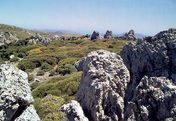
This region is located between Ierapetra and Sitia. It includes the coastline of Tholos and the mountain chain of Thripis. The gorge of "Ha" is one of the most impressive gorges in Crete. The humid ponds are characterized by limited vegetation of annual plants, which are common in other places but rare in Crete, while the dry ponds are characterized by thick vegetation. Equally important are the dolomites near the mountain top "Afentis" and the limestone in the wider region. In the south part of the area, there are small prairies with water springs and rivers of constant flow with waterfowl vegetation.
The kinds of biotope in the area are: Rivers of the Mediterranean with periodic flow, scattered degraded scrublands (garrigues), Sacropoterium spinosum shrubs, Cretan formations (Euphorbieto-Verbascion), sclerophyllous forests used for pasturage (dehesas) with Quercus ilex, screes of the Balkan Peninsula, limestone rock formations of the Aegean, primordial meadows on rock surfaces, protected caves, plane tree forests of the East (Phtanion orientalis), Riparian forests - drifts of the warm Mediterranean (Nerio -Tamarketea), Mediterranean pine forests with endemic species of Mediterranean pine. The area is of great aesthetic value, especially its northern parts. The cave "Theriospilios" is especially important as there are numerous endemic invertebrates and is a relatively large habitat of "myotis myotis" bats. The tops of the mountain chain are very important for the avifauna of Crete. It has one of the richest floras of common and endemic species in the region and in Crete. Its fauna is also rich in endemic invertebrates. The population of mammals in the region is in very good condition.
Finally, there is a variety of well-preserved kinds of biotope, which are not easily accessible. The pine forest of the region is one of the most important in Crete, despite the disasters from bush fires.
Koufonisi Island
The region includes the island of Koufonisi and the small islands in the north (Stroggli, Makrouli, and Marmaros) and the south (Trahilos). The sea part covers the 60% of the region. Koufonisi is a small island with dry and warm climate. This becomes evident from the north-African desert flora, the steppe vegetation, and the presence of the perennial bunch grass Lygeum spartum and Erodium crassifolium.
There are sandy and rocky shores. The sea part of the region is representative and well-preserved and includes sea caves, reefs, and "Posidonia" prairies. There are no permanent inhabitants on the island. During the summer, tourists visit the island; however, there is no extended tourist activity.
The importance of this region is related with its geographical location and the good condition of its natural habitats. From a botanical perspective, the flora and the vegetation of the island are of great interest, as they are characterized by the north African element, which is rare in Crete. There are several endemic plants on the north end of their distribution, such as Zygophyllum alvum, Heliantemum stipulatum and Astragalus pereginus spp. peregrinus, the only known habitats in Crete and Greece. The sea habitats are also very important. Finally, the region combines the biological with the archeological interest. There is an ancient theatre and the island is of great archeological value, even though it has not been completely excavated.
North East End of Crete Dionysades, Elasa & the Peninsula of Sidero (Akra Mayrovouni - Vai - Akra Plaka)
This region includes the Northeast side of Crete, the Peninsula of Sidero and the nearby islands, Dionysades and Elasa. The vegetation mainly consists of shrubs, while in the prairies degraded maquis are preserved. The only palm tree forest in Europe with Phoenix theophrasti is located in Vai. There are water streams that dry up during the summer, riverain vegetation and many aquatic invertebrates. There are 2-3 villages in the whole area. The areas around the villages are cultivated, while there are greenhouses with banana trees. In the east coast, facing the palm tree forest, there are sand dunes. In the west coast, there are "Posidonia" prairies. In the same area, groups of dolphins (Tursiops truncatus) have been spotted. In the end of the Peninsula there is a military base. The islands of Dionysades and Elasa are deserted. The vegetation on these islands is shrubs, while near the sea there are halophyllous plants. The wider region presents a unique flaura and fauna, on the land and in the sea environment. The palm tree forest of Vai is a unique and especially important biotope and has been characterized as the "Aesthetic Forest".




